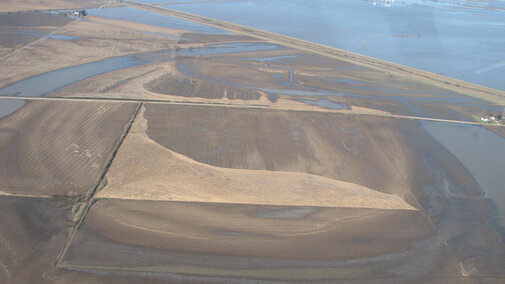Without a doubt, the question of what to do with cornstalks that accumulated almost everywhere has been one of the most frequent question following the March flooding in Nebraska. Cornstalk accumulations have varied from a few inches to a few feet deep. This has and continues to pose a challenge for many farmers as they prepare for spring fieldwork and planting.
This article ...
only addresses cornstalks that have accumulated on ground that is zoned agricultural. Information on how to handle cornstalks that have accumulated on non-agricultural ground is not addressed here. For that information, contact the author or NDEQ.
The Nebraska Department of Environmental Quality (NDEQ) Guidance Document 11-023, Flood Damaged Grain and Hay Disposal, also applies to cornstalks. If you have questions on these guidelines, contact the NDEQ Waste Management Section at (402) 471-4210.
If the layer of stalks isn’t too deep, 4 inches or less, they can be incorporated into the soil with tillage. One word of caution: The soil underneath a layer of cornstalks will dry even slower than fields without the extra crop residue. Doing tillage or other field work before the soil has dried can cause compaction and create ruts, resulting in a greater problem than originally created by the stalks.
Cornstalks are low in nutrients, but will return some nutrients to the soil. On average, mature cornstalks contain about 3 pounds of phosphorus and 24 pounds of potassium per ton of dry matter. However, because these nutrients are tied up in the organic material, they will not all be available the first year. Perhaps the most important contribution to the soil will be the addition of organic matter which can improve soil structure, water infiltration, and nutrient availability.
Options for Managing Cornstalks
If the layer of stalks is greater than four inches, and unfortunately most of them are, there aren’t a lot of good options. The stalks can be burned, spread, composted, or stockpiled for spreading at a later time, probably after harvest this fall. Let’s take a closer look at each of these options.
Burning may be the easiest method IF they dry out enough. When burning, always remember to consider where the fire can travel and get a burn permit from the fire department where you will be burning stalks. If you can get in and spread deeper accumulations without tearing up the field, stalks will dry out faster.
There are two things you’ll want to consider if you burn stalks. First, burning does have an impact on air quality. You may have noticed smoke in the air recently from the burns being conducted in the Flint Hills of Kansas. You also need to consider the wind direction when you are burning and whether smoke will be blowing toward your or your neighbor’s farmstead. Also consider the value of organic matter that could be returned to the soil. However, the positive impact of removing the stalk accumulation may outweigh the loss of organic matter.
Spreading is an option if the stalks aren’t too deep and you have the equipment to do this. Once you spread them, they will dry faster and you can either burn them or incorporate them into the soil. If it fits in your operation, incorporating them is preferred because you get some of the benefit from the organic matter in the debris.
One thing that is important to remember any time you incorporate organic material into the soil, cornstalks and similar debris are high in carbon content and low in nitrogen. The microbes in the soil need nitrogen to break down the carbon-based materials and will take residual nitrogen from the soil to aid in this process. In doing so, they may create a temporary nitrogen deficiency for crops that were planted. You may need to increase your nitrogen fertilizer rate to offset this tie-up of nitrogen in the soil.
Composting cornstalks is not the same as piling them in a corner of the field. To compost cornstalks, you will need to turn and mix them periodically, maybe once a month over the summer. This will increase the rate they break down. You might form a big windrow of stalks along the edge of a field with enough room to turn and mix the stalks with a loader, lifting and pushing the windrow over onto adjacent new ground. Then next time repeat the process and move the windrow back on the original ground.
Stockpiling cornstalks in a pile at the edge of the field will allow for some breakdown to occur, but the rate will be slower than if they were mixed and composted. Stockpiling will take the least ground out of production. Then at a later date, probably this fall after harvest, you can spread the stalks on the field in a layer thin enough that it won’t cause problems with fieldwork or planting the following year.
Even combines with good spreaders tend to leave more residue directly behind the combine. If you are spreading stockpiled stalks, you might want to make your passes with the spreader half way between the passes made by the combine.
Unfortunately there is not a great option for dealing with cornstalks that accumulated because of the flooding in March. You will need to assess the amount of cornstalks and the equipment you have available to determine which option will work best for you to manage them on your farm.

